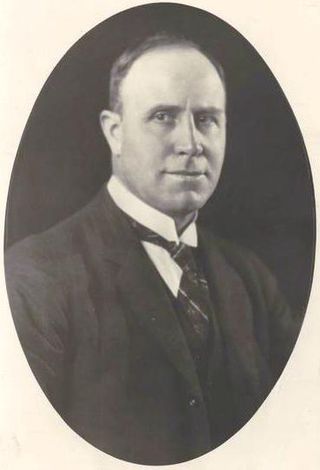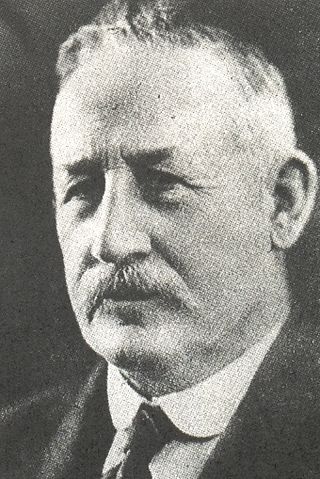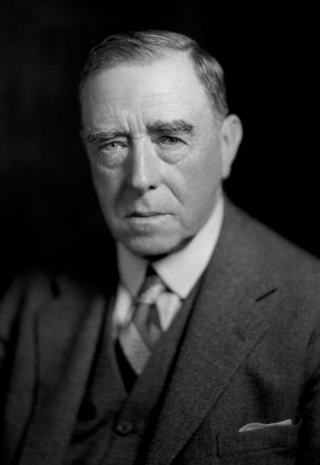The following lists events that happened during 1924 in Australia.

Sir Alexander James Peacock was an Australian politician who served as the 20th Premier of Victoria.

Sir Harry Sutherland Wightman Lawson KCMG, was an Australian politician who served as Premier of Victoria from 1918 to 1924. He later entered federal politics, serving as a Senator for Victoria from 1929 to 1935, and was briefly a minister in the Lyons government. He was a member of the Nationalist Party until 1931, when it was subsumed into the United Australia Party.

John Allan was an Australian politician who served as the 29th Premier of Victoria. He was born near Lancefield, where his father was a farmer of Scottish origin, and educated at state schools. He took up wheat and dairy farming at Wyuna and was director of a butter factory at Kyabram. In 1892 he married Annie Stewart, with whom he had six children.

Sir Stanley Seymour Argyle KBE, MRCS, LRCP, was an Australian radiologist and politician. He served as premier of Victoria from 1932 to 1935 and was the state leader of the Nationalist Party and United Australia Party from 1930 until his death in 1940.

Sir Albert Arthur Dunstan, KCMG was an Australian politician who served as the 33rd premier of Victoria from 1935 to 1943 and from 1943 to 1945 and as the third deputy premier of Victoria for five days in March 1935. A member of the Country Party, now the National Party, his term as premier was the second-longest in the state's history and the longest of any third-party premier. He was the first person to hold the office of premier in its own right, and not an additional duty taken up by the Treasurer, Attorney-General or Chief Secretary.
The 1918 Swan by-election was a by-election for the Division of Swan in the Australian House of Representatives, following the death of the sitting member Sir John Forrest. Held on 26 October 1918, the by-election led to the election of the youngest person to be elected until 2010 to the Parliament of Australia, Edwin Corboy. It saw the conservative vote split between the Country Party and the Nationalist Party, which directly prompted the introduction of preferential voting in Australia.
The Victorian Farmers' Union (VFU) was an association of farmers and primary producers formed in 1914 in the Australian state of Victoria. Although initially formed as an "absolutely non-political" entity, the VFU became a political party in 1916, and nominated candidates for the 1917 state election and subsequent elections. In later years it used the names Victorian Country Party, then United Country Party and is now the National Party of Australia – Victoria. At the 1917 election, because the support for the VFU was concentrated in rural seats, it won four of the 11 seats in the Victorian Legislative Assembly it contested, gaining about 6% of the vote state-wide. In 1918 it also won its first seat in the federal parliament, after preferential voting was introduced. At the 1920 state election the VFU vote increased to 8% and the number of seats to 13, giving the VFU the balance of power in the state Legislative Assembly.

Sir Albert John Gould, VD was an Australian politician and solicitor who served as the second president of the Australian Senate.
This article provides information on candidates who stood for the 1931 Australian federal election. The election was held on 19 December 1931.
The First Dunstan Ministry was the 49th ministry of the Government of Victoria. It was led by the Premier of Victoria, Albert Dunstan. The ministry was sworn in on 2 April 1935, and was the first Country Party ministry in the history of Victoria.
The Allan Ministry was the 44th ministry of the Government of Victoria. It was led by the Premier of Victoria, John Allan, and was formed by a coalition of the Country and Nationalist parties. The ministry was sworn in on 18 November 1924.

The 1917 Victorian state election was held in the Australian state of Victoria on Thursday 15 November 1917 for the state's Legislative Assembly. 51 of the 65 Legislative Assembly seats were contested.
The Second Hogan Ministry was the 47th ministry of the Government of Victoria. It was led by the Premier of Victoria, Edmond Hogan, and consisted of members of the Labor Party. The ministry was sworn in on 12 December 1929.
The Argyle Ministry was the 48th ministry of the Government of Victoria. It was led by the Premier of Victoria, Stanley Argyle, and consisted of members of the United Australia Party (UAP) and the Country Party. The ministry was sworn in on 19 May 1932. On the 20th of March 1935, following the 1935 election, the Country party withdrew from the Coalition. Argyle then formed a new ministry of UAP members. The ministry was dissolved as a result of Argyle's resignation following defeat in the Legislative Assembly.
The Third Peacock Ministry was the 42nd ministry of the Government of Victoria. It was led by the Premier of Victoria, Sir Alexander Peacock, and consisted of members of the Nationalist Party. The ministry was sworn in on 28 April 1924 following Peacock becoming leader of the Nationalist Party after the collapse of the Nationalist-Country Coalition government led by Harry Lawson. The ministry dissolved following the Nationalist Party's loss at the 1924 state election and was succeeded by George Prendergast's Labor government.
The First Hollway Ministry was the 54th ministry of the Government of Victoria. It was led by the Premier of Victoria, Thomas Hollway, and consisted of members of the Liberal and Country parties. Hollway led a Liberal-Country coalition until the Country Party ministers resigned on 3 December 1948. He then led an interim Liberal ministry until 8 December, when he formed a full Liberal ministry. The ministry were sworn in on 20 November 1947, 3 December 1948, and 8 December 1948.
The Liberal Party, often known simply as the Liberals, was the name used by a number of political groupings and parties in the Victorian Parliament from the late 19th century until around 1917.
The Bowser Ministry was the 40th ministry of the Government of Victoria. It was led by the premier of Victoria, John Bowser, and consisted of members of the Nationalist Party. The ministry was sworn in on 29 November 1917 following the party's victory in the 1917 state election. The Bowser government was defeated in 1918 and succeeded by the Lawson ministry in which Bowser held cabinet positions.
The Second Peacock Ministry was the 39th ministry of the Government of Victoria. It was led by the premier of Victoria, Alexander Peacock, and consisted of members of the Commonwealth Liberal Party, later known as the Nationalist Party. The ministry was sworn in on 18 June 1914 following the resignation of Premier William Watt to contest the 1914 federal election. The government was defeated at the 1917 state election by the anti-Peacock faction of the Nationalist party and succeeded by the Bowser ministry.






